Traditional Uzbek Dishes to Try
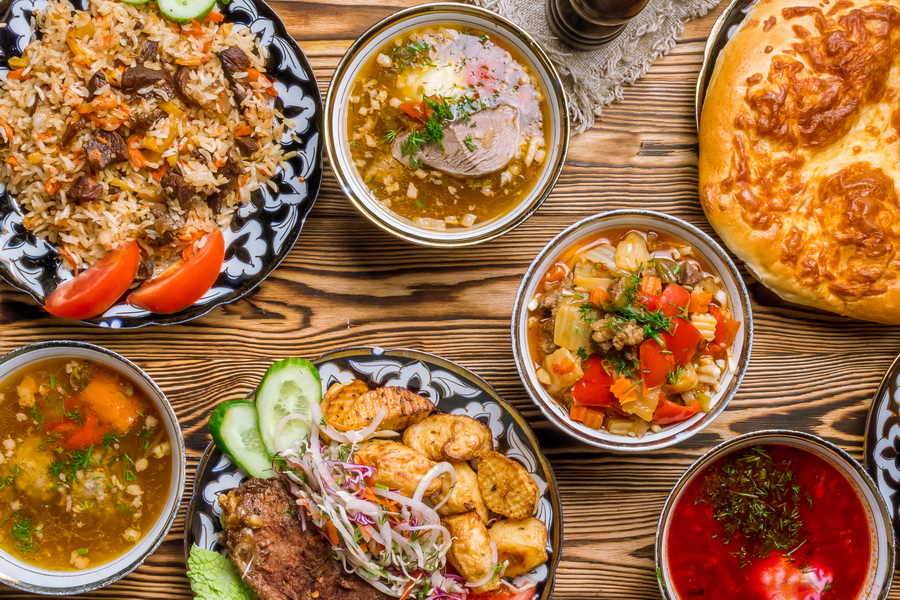 Popular Uzbek Dishes
Popular Uzbek Dishes
Uzbek cuisine is known for its rich tastes and variety. So popular are several Uzbek dishes that they can now be found in many countries around the world, yet to enjoy authentic Uzbek food you must, of course, go to the source itself. After tasting the items on our list of 10 Uzbek dishes you have to try, you will find yourself asking "Why am I only now discovering Uzbek cuisine?!"
Plov
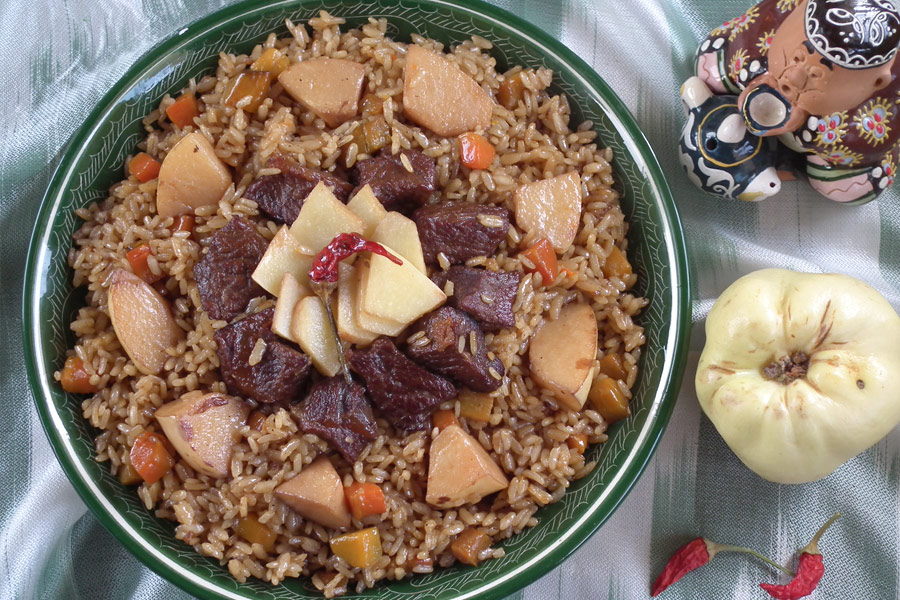
Without a doubt, topping any list of traditional Uzbek dishes to try is plov. So tasty is Uzbek plov (pilaf) that it is included in the UNESCO Intangible Cultural Heritage List. If you have not tried this tasty dish made from meat, rice, vegetables and spices then you have not been to Uzbekistan, for this is the meal of choice to serve to guests.
Each region in Uzbekistan has its own type of plov. For example, Tashkent plov is different from Samarkand and Khorezm plov. It is estimated that there are over 200 types of plov in the country, and even more family recipes. Special cooking methods and ingredients are passed from father to son and from oshpaz (cook) to student. The most famous type is teahouse plov, although the most delicious is said to be toi oshi (wedding plov) which contains chickpeas, raisins, quail eggs and kazy (horse meat sausage). Wherever you try pilaf, be it an expensive Tashkent restaurant or a small teahouse in Kashkadarya, it will not disappoint!
Shashlik

In Central Asian countries, including Uzbekistan, shish kebab is called shashlik. In Uzbekistan the word ‘kebab’ is usually associated with a separate dish called kazan-kabob, which has nothing to do with barbecue.
Shashlik is skewered, marinated meat which is fried over charcoal or fruit tree firewood. Along with high-quality meat and firewood, the use of tail fat and a good marinade are essential for tasty shashlik. All shashlik is marinated, although each chef has his own secret recipe.
The most common type of shashlik consists of beef chunks which are alternated on the skewer with tail fat, resulting in a juicy, flavorful kebab. Other popular varieties of shashlik in Uzbekistan include mutton shashlik, lyulya-kebab (ground shashlik), jigar (liver shashlik), chicken, vegetable and fish shashlik and even shashlik made from quail (bedona). With every variety, sliced onions sprinkled with vinegar are served alongside the kebab.
Manty
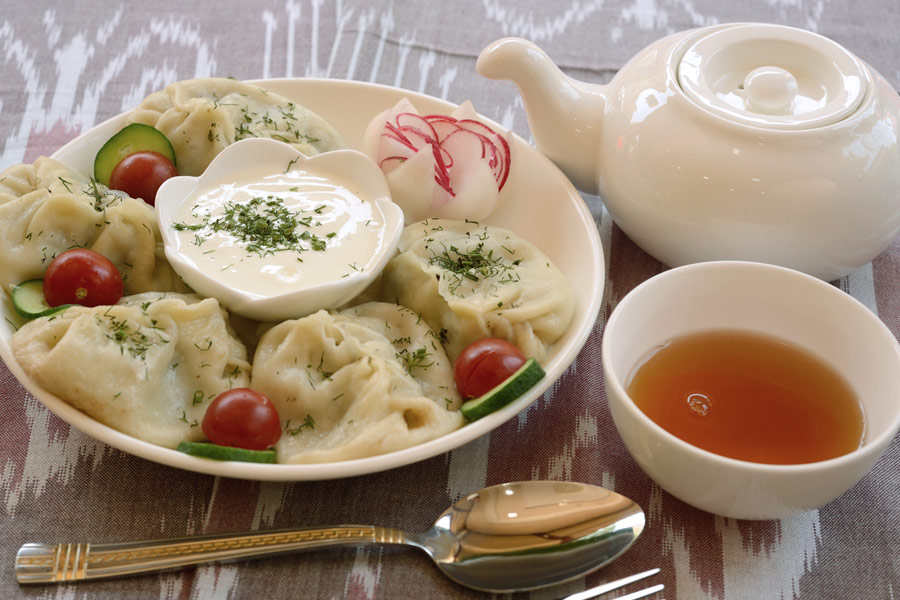
Uzbek dough dishes are very diverse, yet a steamed meat dumpling called manty (manti) is a favorite of many. With its delicate dough and juicy filling, manty is filling and satisfying.
Flour, water, salt and sometimes an egg are mixed together for the dough, which should be rolled out as thinly as possible without breaking. Ground beef is the most common filling, although manty with lamb, pumpkin or potatoes can occasionally be found. To prepare the filling, many finely chopped onions, salt and pepper are added to the filling of choice. The onions are essential, for they produce a juicy dish. When made with meat, tail fat is also added.
The dough is cut into squares and a dollop of filling is placed on each. The manti is then folded shut, usually with the edges pulled back on both sides like an envelope. The dumplings are steamed in a special multi-tiered double boiler for 30-40 minutes, depending on the filling.
A bowl of kaymak (a fermented milk product similar to sour cream) is served with manty.
Hanum

This traditional Uzbek dish is loved in every family. Like manty it is also steamed, yet it has a unique taste and is served with different condiments.
The dough is kneaded in water (occasionally in milk), left to sit and rolled into a large circle of average thickness. The filling is spread on top before it is wrapped into a large roll. Hanum is traditionally made from potatoes and onions, and occasionally with minced meat or pumpkin.
The rolled dough is placed in a double boiler which has been greased with sunflower oil and is cooked for 30-40 minutes, with meat varieties requiring a longer cooking time. Before serving, hanum is cut into pieces. It is usually eaten with a specially prepared tomato sauce.
Samsa
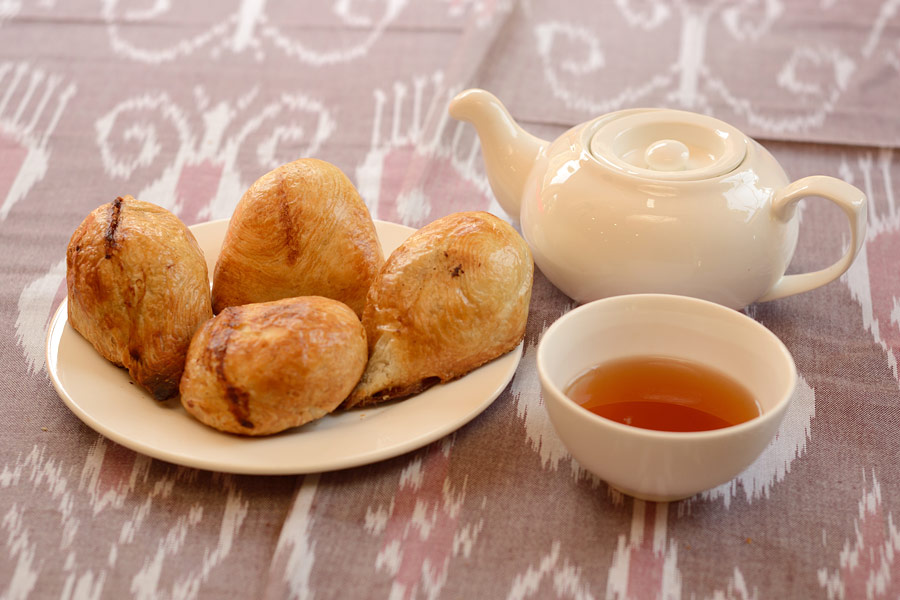
Among traditional Uzbek dishes to try, samsas remain a crowd pleaser. Unlike typical street food, samsas (somsas) are satisfying and very delicious. Yet they are not only sold on the streets, for you will find samsas on the table at many special gatherings.
Uzbek samsas may be filled with minced meat and tail fat, potatoes, pumpkin, mushrooms, spinach, chicken or cheese. It is customary to cook samsas in a traditional clay oven called a tandoor. Alternatively, they can be baked in a regular oven for about 40 minutes. They can be formed into different shapes and sizes; mini-samsas can be smaller than a child's hand, while large samsas can fill the palm of a grown man.
Most Uzbek samsas are made from a flaky pastry. The flour is sifted through a sieve, forming a mound, and a small depression is made into it. Warm water, a little sunflower oil and salt are added to produce a firm yet slightly sticky dough. The dough is divided into 3-4 parts which are greased with oil, wrapped and set in the refrigerator. Once they have chilled, each piece is rolled out until very thin, greased with melted butter and wrapped around a rolling pin in layers. The dough is then cut with a knife, removed from the rolling pin, divided into small portions and again rolled out. A spoonful of filling is placed onto each piece and the dough is folded to form a triangle or square. The tops are spread with egg yolk and sprinkled with sesame seeds before baking.
Tukhum barak
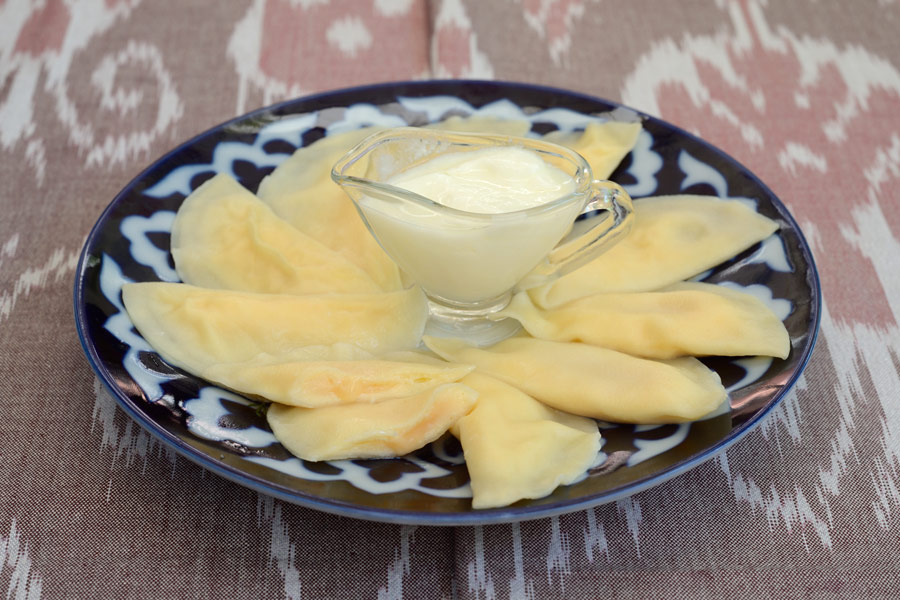
Tukhum barak, a unique dish, are dumplings stuffed with eggs which are primarily made in Khorezm in western Uzbekistan.
To prepare this hearty dish, a dumpling dough made of flour, water, egg and salt is prepared. To make the filling, eggs are beaten with a fork and mixed with milk, butter and seasonings.
After the dough has sat for 15-20 minutes, it is rolled out into a thin layer and cut into equal-sized pieces which are sealed to form squares with a small opening on top. A tablespoon of boiling water is then poured into each square. The dumplings are placed in water, covered with a lid and boiled.
Mashhurda
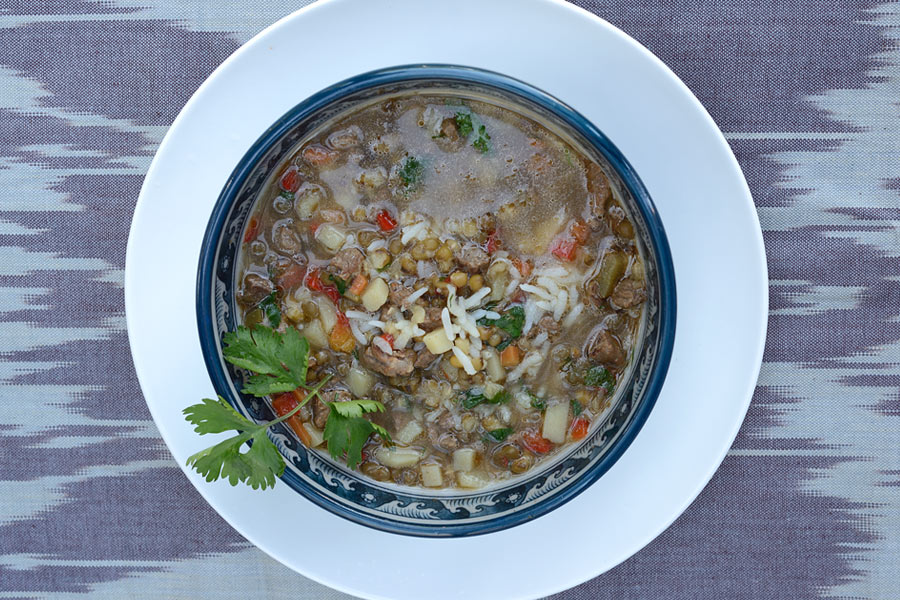
Uzbek cuisine would not be complete without its many hearty soups. Mashhurda is a dish made from rice, mung beans and vegetables which can be served as either a first or second course.
To prepare, beef and vegetables are chopped into small cubes. The rice and mung beans are rinsed and left to soak in separate containers as sunflower oil is heated in a pot. Onions are added and fried until golden brown, followed by the meat. After a few minutes, carrots and potatoes are added, and lastly bell peppers, tomatoes and garlic. Once the vegetables have set, the mung beans are fried for 5-7 minutes. They are then covered with water, brought to a boil and simmered until the skins begin to crack. The rice is added and the soup seasoned with spices and cooked for 15-20 minutes, or until tender. It is served with kaymak (sour cream) and herbs.
Dolma

Dolma is a dish which combines the amazing taste of meat and grape leaves. Apart from being delicious, it is also known to aid digestion.
Usually young grape leaves are used for dolma, but if the dish is not prepared in spring then grape leaves may be salted in advance. If using fresh leaves, boiling water should be poured over them and left for 3-4 minutes. The water is then drained and the leaves left to cool. Salted leaves may be used immediately.
Beef is placed through a meat grinder and mixed with finely chopped or grated onions and tomatoes, rice, mint and spices. The grape leaves are laid out smooth side down and the filling is put in the middle of each leaf. The leaves are then wrapped to completely cover the minced meat.
The dolma are packed tightly into a pot or saucepan and just enough water or broth is poured over them so that they are completely covered. A plate or other small weight should be placed on top of the dolma so that they do not turn over while cooking on low heat for about 35 minutes. If the dish is left to sit for 1-2 hours before serving, it is even tastier!
Laghman
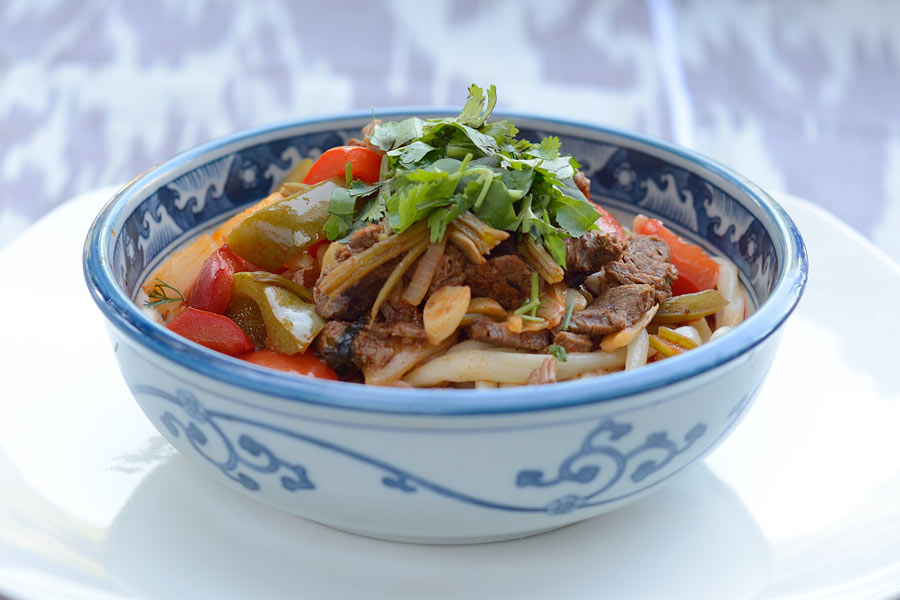
Laghman is a traditional Uzbek noodle soup made by hand.
Preparing the noodles is a time-consuming process. First, flour is sifted in a sieve. A depression is then formed into which warm water, a room-temperature egg and salt are added. The dough is kneaded until elastic, cut into rectangles and formed into ropes about 2 centimeters thick. The ropes are greased with vegetable oil, shaped into a spiral on a flat dish, covered with plastic wrap or a towel and left for half an hour. Working with one piece at a time, they are stretched until they have reached a desired diameter and are then wrapped around the hands like yarn and gently slapped on the table. The noodles are then boiled in salted water and drizzled lightly with oil so that they do not stick together.
Separately, meat, onions, carrots, tomatoes, bell peppers, potatoes, garlic, herbs and spices are fried. Water is poured over them and they are left to cook for about 20-25 minutes. When serving laghman, the meat and vegetables are scooped onto the noodles before broth is poured over the dish.
Halva
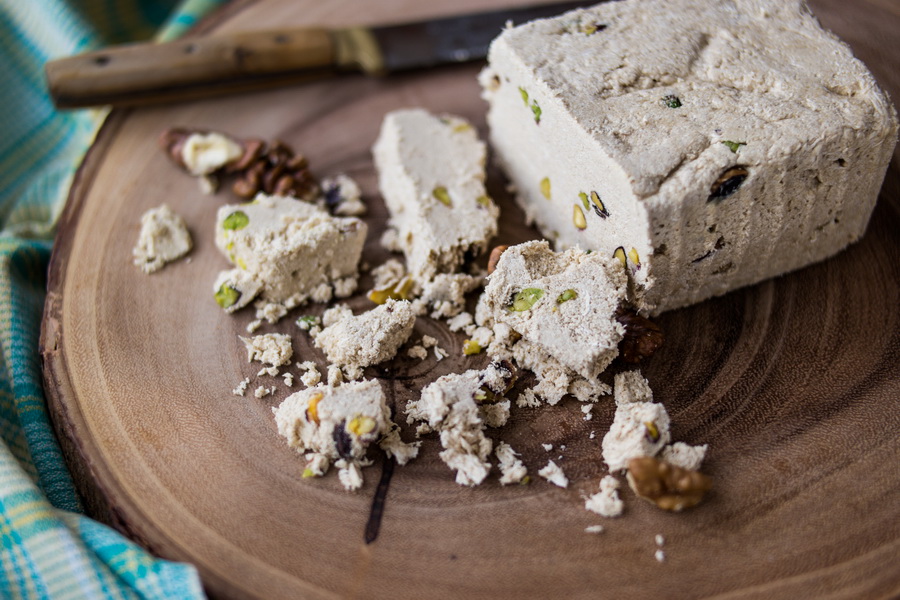
There are many sweets in Uzbekistan, but halva is perhaps the most famous. And in our list of 10 Uzbek dishes you have to try, not including halva is just a crime.
Guests are often treated to it, while tourists take it home in large quantities for gifts. There are dozens of halva varieties, including halva made from flour, dairy, butter, chocolate, peanuts, sesame seeds, fruit and more. The most popular types of halva are found in Kokand and Samarkand.
Classic halva is prepared by adding flour to boiling ghee over low heat and stirring the mixture constantly. Separately, sugar is dissolved in milk and brought to a boil. Then the milk is added to the flour, which should acquire a golden hue. The mass is stirred and left to simmer for 15-20 minutes. Nuts are then chopped, lightly fried, mixed into the thickened halva and poured into a mould. After the halva hardens, it is cut into rhombuses or rectangles.

